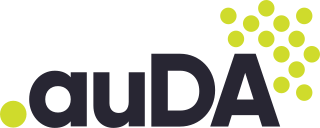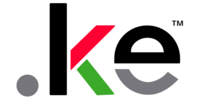
The Internet Corporation for Assigned Names and Numbers is a global multistakeholder group and nonprofit organization head-quartered in the United States responsible for coordinating the maintenance and procedures of several databases related to the namespaces and numerical spaces of the Internet, ensuring the Internet's stable and secure operation. ICANN performs the actual technical maintenance work of the Central Internet Address pools and DNS root zone registries pursuant to the Internet Assigned Numbers Authority (IANA) function contract. The contract regarding the IANA stewardship functions between ICANN and the National Telecommunications and Information Administration (NTIA) of the United States Department of Commerce ended on October 1, 2016, formally transitioning the functions to the global multistakeholder community.
A domain name registry is a database of all domain names and the associated registrant information in the top level domains of the Domain Name System (DNS) of the Internet that enables third party entities to request administrative control of a domain name. Most registries operate on the top-level and second-level of the DNS.
Reverse domain name hijacking, occurs where a rightful trademark owner attempts to secure a domain name by making cybersquatting claims against a domain name’s "cybersquatter" owner. This often intimidates domain name owners into transferring ownership of their domain names to trademark owners to avoid legal action, particularly when the domain names belong to smaller organizations or individuals. Reverse domain name hijacking is most commonly enacted by larger corporations and famous individuals, in defense of their rightful trademark or to prevent libel or slander.

.xxx is a sponsored top-level domain (sTLD) intended as a voluntary option for pornographic sites on the Internet. The sponsoring organization is the International Foundation for Online Responsibility (IFFOR). The registry is operated by ICM Registry LLC. The ICANN Board voted to approve the sTLD on 18 March 2011. It went into operation on 15 April 2011.
Domain name speculation, popular as domaining in professional jargon, is the practice of identifying and registering or acquiring generic Internet domain names as an investment with the intent of selling them later for a profit.
Online dispute resolution (ODR) is a form of dispute resolution which uses technology to facilitate the resolution of disputes between parties. It primarily involves negotiation, mediation or arbitration, or a combination of all three. In this respect it is often seen as being the online equivalent of alternative dispute resolution (ADR). However, ODR can also augment these traditional means of resolving disputes by applying innovative techniques and online technologies to the process.

.au is the Internet country code top-level domain (ccTLD) for Australia. It was created on 5 March 1986. Domain name policy is managed by .au Domain Administration (auDA). As of July 2018, the registry is operated by Afilias.
The Anticybersquatting Consumer Protection Act (ACPA), 15 U.S.C. § 1125(d),(passed as part of Pub. L.Tooltip Public Law 106–113 ) is a U.S. law enacted in 1999 that established a cause of action for registering, trafficking in, or using a domain name confusingly similar to, or dilutive of, a trademark or personal name. The law was designed to thwart "cybersquatters" who register Internet domain names containing trademarks with no intention of creating a legitimate web site, but instead plan to sell the domain name to the trademark owner or a third party. Critics of the ACPA complain about the non-global scope of the Act and its potential to restrict free speech, while others dispute these complaints. Before the ACPA was enacted, trademark owners relied heavily on the Federal Trademark Dilution Act (FTDA) to sue domain name registrants. The FTDA was enacted in 1995 in part with the intent to curb domain name abuses. The legislative history of the FTDA specifically mentions that trademark dilution in domain names was a matter of Congressional concern motivating the Act. Senator Leahy stated that "it is my hope that this anti-dilution statute can help stem the use of deceptive Internet addresses taken by those who are choosing marks that are associated with the products and reputations of others".
.ai is the Internet country code top-level domain (ccTLD) for Anguilla, a British Overseas Territory in the Caribbean. It is administered by the government of Anguilla.

.ba is the Internet country code top-level domain (ccTLD) for Bosnia and Herzegovina. It is administered by the University Teleinformation Center.

The Internet country code top-level domain (ccTLD) .io is nominally assigned to the British Indian Ocean Territory. The domain is managed by Internet Computer Bureau Ltd, a domain name registry, with registrar services provided by Name.com.
The Uniform Domain-Name Dispute-Resolution Policy (UDRP) is a process established by the Internet Corporation for Assigned Names and Numbers (ICANN) for the resolution of disputes regarding the registration of internet domain names. The UDRP currently applies to all generic top level domains, some country code top-level domains, and to all new generic top-level domains.

.ly is the Internet country code top-level domain (ccTLD) for Libya.
.no is the Internet country code top-level domain (ccTLD) for Norway. Norid, the domain name registry, is based in Trondheim, is owned by the state-owned Uninett and operates under supervision of the Norwegian Communications Authority. As of December 24, 2022 there were 843,749 registered .no domains. Organizations with a presence in Norway and registration at the Brønnøysund Register Centre are limited to 100 domains each. Individuals residing in Norway may register in the second-level domain priv.no and, as of June 17, 2014, directly under .no. Other second-level domains exist for organizations of certain types, such as municipalities and schools. The strict regulations have resulted in near-absence of cybersquatting and warehousing.

.tz is the Internet country code top-level domain for Tanzania. Through a consultative process, Tanzania Network information Centre (tzNIC), a not-for-profit company was established and registered to administer and manage the operations of the Tanzania country code top-level domain. tzNIC is a limited company with two founding members – the Tanzania Communication Regulatory Authority and the Tanzania Internet Service Provider Association.

A trademark is a type of intellectual property consisting of a recognizable sign, design, or expression that identifies a product or service from a particular source and distinguishes it from others. A trademark owner can be an individual, business organization, or any legal entity. A trademark may be located on a package, a label, a voucher, or on the product itself. Trademarks used to identify services are sometimes called service marks.
Cybersquatting is the practice of registering, trafficking in, or using an Internet domain name, with a bad faith intent to profit from the goodwill of a trademark belonging to someone else.

Lamparello v. Falwell, 420 F.3d 309, was a legal case heard by the United States Court of Appeals for the Fourth Circuit concerning allegations of cybersquatting and trademark infringement. The dispute centered on the right to use the domain name fallwell.com, and provides discussion on cybersquatting as it applies to criticism of a trademark.

.au Domain Administration (auDA) is the policy authority and industry self-regulatory body for the .au domain, which is the country-code top-level domain (ccTLD) for Australia. It was formed in 1999 to manage the .au ccTLD with the endorsement of the Australian Government and the authority of the Internet Corporation for Assigned Names and Numbers (ICANN). It is a not-for-profit membership organisation that promotes and protects the .au domain space.

The Trademark Clearinghouse is a database of validated and registered trademarks established by ICANN to assist trademark holders prevent infringing behavior in the Domain Name System. In combination with the Uniform Rapid Suspension System (URS), it is the second significant attempt by ICANN to handle the "Trademark Dilemma". The first attempt was the Uniform Domain-Name Dispute-Resolution Policy.










